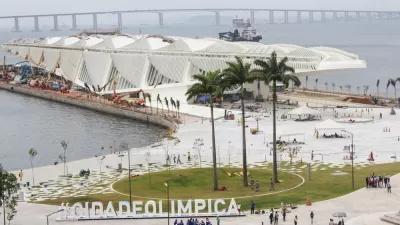This article from National Geographic looks at the construction boom that is rapidly changing the face of Beijing.
"Wang and his crew are part of an army of largely unskilled workers, more than a million strong, that has helped turn Beijing into what is perhaps the largest construction zone in history, with thousands of new projects under way. Once a flat cityscape dominated by the imperial Forbidden City and monumental but drab public buildings, Beijing has been struck by skyscraper fever. Over the past 30 years, China's economy has averaged nearly 10 percent annual GDP growth, driven by the marriage of world-class technology with a vast low-cost workforce. That same dynamic has turned China into an architects' playground, first in Shanghai in the 1990s as its skyline filled in with high-rise marvels, and now in Beijing, which is building at a mad pace in preparation for the 2008 Summer Olympic Games in August."
"Beijing's newest buildings push aesthetic and technological bounds, each outshimmering the last. Most major projects have been designed by foreign architects: Chinese clients crave innovation and hunt beyond China to get it, says American architect Brad Perkins, founder of Perkins Eastman in New York. During Mao's Cultural Revolution, architects were more technicians than artists (even the term architect was considered bourgeois), and private architectural firms were a rarity until a decade ago. 'By turning to foreigners like me,' says Perkins, 'the Chinese are buying 30 to 40 years of experience they didn't have.'"
FULL STORY: The New Great Walls

Alabama: Trump Terminates Settlements for Black Communities Harmed By Raw Sewage
Trump deemed the landmark civil rights agreement “illegal DEI and environmental justice policy.”

Study: Maui’s Plan to Convert Vacation Rentals to Long-Term Housing Could Cause Nearly $1 Billion Economic Loss
The plan would reduce visitor accommodation by 25% resulting in 1,900 jobs lost.

Why Should We Subsidize Public Transportation?
Many public transit agencies face financial stress due to rising costs, declining fare revenue, and declining subsidies. Transit advocates must provide a strong business case for increasing public transit funding.

Paris Bike Boom Leads to Steep Drop in Air Pollution
The French city’s air quality has improved dramatically in the past 20 years, coinciding with a growth in cycling.

Why Housing Costs More to Build in California Than in Texas
Hard costs like labor and materials combined with ‘soft’ costs such as permitting make building in the San Francisco Bay Area almost three times as costly as in Texas cities.

San Diego County Sees a Rise in Urban Coyotes
San Diego County experiences a rise in urban coyotes, as sightings become prevalent throughout its urban neighbourhoods and surrounding areas.
Urban Design for Planners 1: Software Tools
This six-course series explores essential urban design concepts using open source software and equips planners with the tools they need to participate fully in the urban design process.
Planning for Universal Design
Learn the tools for implementing Universal Design in planning regulations.
Smith Gee Studio
Alamo Area Metropolitan Planning Organization
City of Santa Clarita
Institute for Housing and Urban Development Studies (IHS)
City of Grandview
Harvard GSD Executive Education
Toledo-Lucas County Plan Commissions
Salt Lake City
NYU Wagner Graduate School of Public Service



























